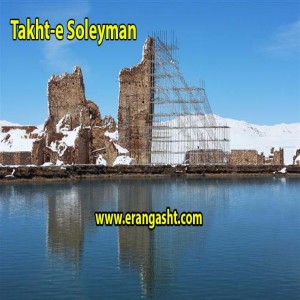
Tourism Information of Takht-e Soleyman
Takht-e Soleyman, built in Sassanid era (224 – 652 CE), was an important religious center for Zoroastrians. Takht-e Soleyman was surrounded by a 13m high wall with 38 towers and two gates on the north side and south side.
Main buildings of the complex were located on the north side of a lake which was inside the enclosure. This natural lake that has a diameter of 100 meters and a depth of 62 meters was sacred for Zoroastrians since it was attributed to Anahita, the goddess of water.
These buildings had formed a square enclosure. At the center of this enclosure, the square-shaped fire temple of “Azargoshasb” was situated, which had a great importance especially for Sassanian kings and warriors. On east side of the temple there was another square-shaped hall that was the place to preserve and watch over the eternal fire (Zoroastrians had a great respect for the four elements: Water, Air, Earth and Fire amongst which fire enjoyed the highest reverence). The Anahita temple was located in eastern part of fire temple. The imperial residences were located at the west of the temples

The original name of this complex was not ‘Takht-e Soleyman’, and it has been called by diverse names in different eras and languages. According to a myth, once Arabs attacked and occupied the area, the Zoroastrians attributed this place to Prophet Solomon (Solomon the King) in order to protect the fire temple and to prevent its immediate destruction. They knew that Muslims had great respect for Solomon, so they said that Solomon has stayed in this place for a while. Their trick was useful and Takht-e Soleyman was saved from destruction. This complex is currently called by this name.
This site that still has a great symbolic importance for Zoroastrians was occupied by Romans during the war between “Khosrow Parviz” (r. 590-628 CE) and “Heraclius” and then lost its prosperity. But once again it flourished in Ilkhanid Era and some other buildings were also added to the complex. From the 14th century onwards, the site was abandoned and was gradually destroyed. “Sir Robert Ker Porter” rediscovered this site in 1819 and thereafter
several archaeological excavations have been conducted on it. Takht-e Soleyman Historical Complex was inscribed as a World Cultural Heritage by UNESCO in 2003. It is located in the north west of Iran, at a distance of 43 kilometers from “Takab City” in “West Azerbaijan Province”.
Crafts
Museums
View More














